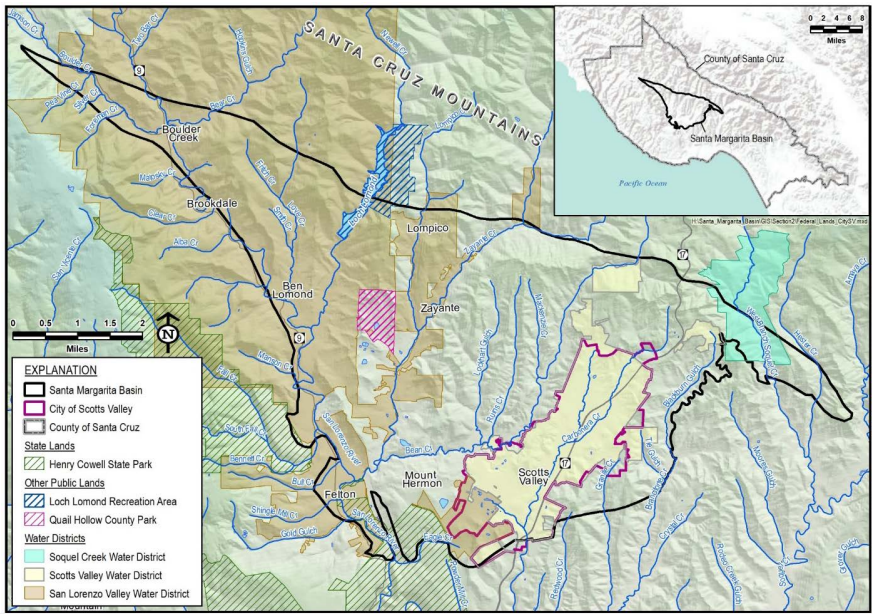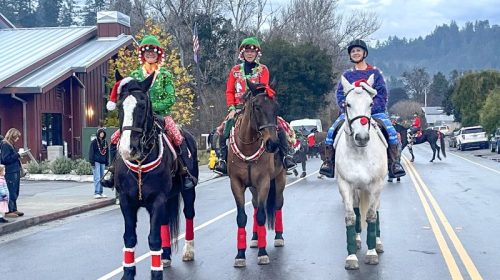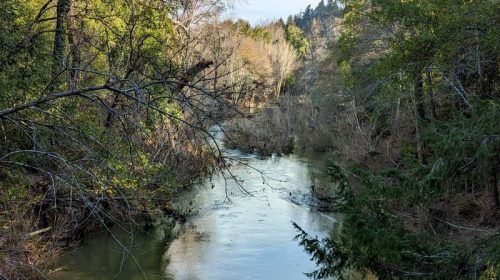Santa Margarita Groundwater Agency and Upcoming Water District Plans
By Bob Fultz
It’s important that we all stay current with the activities of the Santa Margarita Groundwater Agency (SMGA), since their actions could have a significant impact on local control and cost of water in San Lorenzo Valley Water District (SLVWD).
A bit of background. The Santa Margarita Aquifer has been designated by the State of California as being a “medium priority” basin with respect to overdrafting, scoring only 2.5 points away from a “low priority” classification where a mitigation plan is not required. The medium designation obligates our community to develop a plan for aquifer recharge over the next 20 years.
To that end, after an intense effort over several years, the SMGA submitted its Groundwater Sustainability Plan (GSP) to the California Department of Water Resources, which posted it on January 14, 2022, and is still under State review.
There was a lot of positive information in the GSP submitted by the SMGA. It did an excellent job of analyzing our situation and provided a number of common-sense and reasonable plans for recharging the aquifer, specifically in two main areas. First is redistribution of excess surface water inside of the SLVWD, as well as sharing excess surface water with Scotts Valley Water District (SVWD) during the winter months in order to rest the SVWD wells and thereby use even less groundwater.
Second is conservation, where both SLVWD and SVWD customers excel in reducing water use on a per person basis. In fact, the SLVWD is recognized as having some of the lowest water usage in the entire state. Increased conservation helps recharge the aquifer naturally. In addition, the fact that the San Lorenzo Valley residents are all on septic systems means that a good share of the water discharged from our homes also finds its way—eventually—back into the aquifer.
These very positive factors informed my critique of the GSP, which was included in the report, that focused on financial feasibility and objected to including an outlier proposal for Aquifer Storage and Recovery (ASR). ASR is the use of high-pressure injection wells to force treated water into our aquifer. This technique is usually used elsewhere as a last resort to combat severe overdraft conditions or saltwater intrusion, neither of which apply to our area. In my opinion, given the size, financial resources, residential character and demographics of our community, these injection wells represent an unjustified high-cost, high-risk, nonviable solution for groundwater management. My recommendation was to delete this item so that no agency would be tempted to pursue this path and worse, attempt to include the residents of the SLVWD in such a scheme.
SMGA responded with reassurance: “It is assumed that the relatively simpler, cheaper and/or more cost-efficient projects will be implemented first, and based on performance of those projects with respect to groundwater sustainability, the more costly and complicated projects might need to be considered and executed.” This assurance seemed to be good news for our community, where the various agencies involved in the effort to recharge our aquifer would focus on practical, economic, sustainable protections.
Unfortunately, that all changed when the City of Santa Cruz’s Water Department stepped in and unilaterally blocked SLVWD’s plans for perfecting its water rights to support wider distribution of excess surface water, which is the key to letting wells rest and allowing the aquifer to recover. This setback now involves delays that may take many years to resolve. I believe any objections the City had to the SLVWD’s plans could have easily been resolved via negotiation between the parties. However, it is now apparent that the City of Santa Cruz Water Department and, to a lesser extent, the SVWD, are very interested in ASR and injection wells, perhaps due to their communities’ growth plans and their resulting need for water. By contrast, the San Lorenzo Valley is a no-growth community with limited financial resources and important priorities to attend to—like rebuilding infrastructure not attended to for decades and recovering from the CZU fire. SLVWD residents cannot afford to spend money on such risky projects, especially when there are much lower-cost alternatives to protect and recharge our aquifer.
The priorities for SVWD and the City of Santa Cruz Water Department are clearer when we examine the current grant funding opportunity being pursued by the SMGA. As presented to the SLVWD Board for approval on 12/1/2022, almost 75% of the money requested to support sustainability projects are for projects related to ASR and injection wells, though the language in the grant request summary wouldn’t give you any hint of that. Regrettably, this does not follow the SGMA reassurance that ASRs are “back burner” ideas, not to be considered until lower cost lower risk projects have been exhausted and proven over years to not meet the goal.
My policy position is clear and remains unchanged: SLVWD should focus exclusively on making more efficient use of its significant surface water resources and the common-sense plans included in the GSP. Then, after operating at greater efficiency for 7 years, evaluate whether or not the aquifer is being replenished at a rate fast enough to achieve sustainability in the required 20 years. If not, then re-evaluate and make adjustments. But let’s not spend endless money on consultants and studies for something that doesn’t make sense for our area.
With your support, as long as the SLVWD doesn’t have anything to do ASR and injection wells, projects that are inappropriate for our area and needs, we can watch the SVWD and the City of Santa Cruz Water Department spend their money—and the money of the California taxpayers—on these risky projects while the SLVWD attends to its priorities, which are (a) to complete the recovery from the CZU fire, (b) perfect our water rights to allow our District to do an even better job of distributing excess surface water inside our District, and (c) focusing on operating efficiencies so as to reduce the rate of growth in our District’s skyrocketing operating costs—and rates. Strengthening our District’s water efficiencies, infrastructure, and finances enables us to better withstand—and reject—any demands from neighboring agencies that our community should help pay for something simply not justifiable environmentally or economically.
Bob Fultz is a member of the San Lorenzo Valley Water District Board of Directors but is speaking only for himself in these columns. He is a resident of Boulder Creek and CEO at Range Networks.
Featured image: Santa Margarita Groundwater Basin Location (smgwa.org)
The San Lorenzo Valley Post is your essential guide to life in the Santa Cruz Mountains. We're dedicated to delivering the latest news, events, and stories that matter to our community. From local government to schools, from environmental issues to the arts, we're committed to providing comprehensive and unbiased coverage. We believe in the power of community journalism and strive to be a platform for diverse voices.






Good article Bob, I agree with you that ASR is not needed or cost efficient for the SLV water district. Might be OK for Scotts Valley with their urban sprawl and covering all of their ground water with parking lots, condos and empty businesses. Seems like there is not much truth in what most local, state and federal agencies are feeding us. Just unending spending on a bunch of poorly thought out knee jerk ideas that only benefit small numbers of people and appointed “officials”. We have already spent endless amounts money on consultants and studies that went no where and only send money out of our area to people that have no idea of what is going on in the San Larenzo Valley.